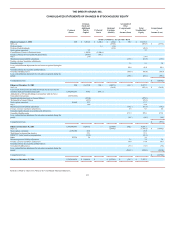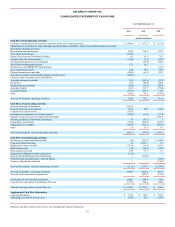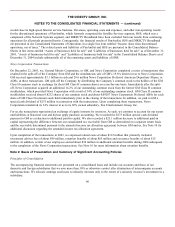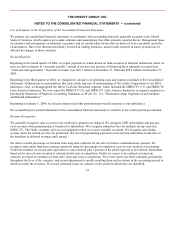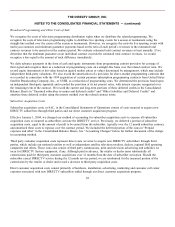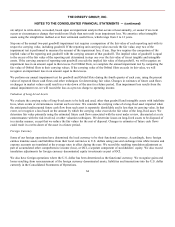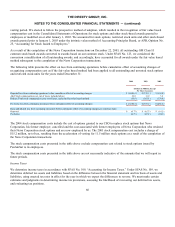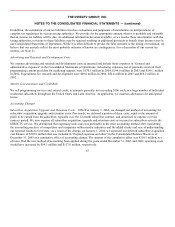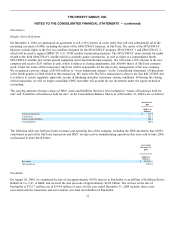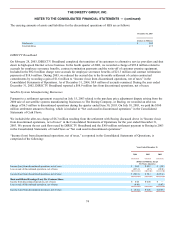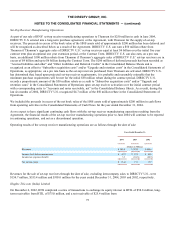DIRECTV 2004 Annual Report Download - page 74
Download and view the complete annual report
Please find page 74 of the 2004 DIRECTV annual report below. You can navigate through the pages in the report by either clicking on the pages listed below, or by using the keyword search tool below to find specific information within the annual report.
THE DIRECTV GROUP, INC.
NOTES TO THE CONSOLIDATED FINANCIAL STATEMENTS — (continued)
Investments and Financial Instruments
We maintain investments in equity securities of unaffiliated companies. We carry non-marketable equity securities at cost. We
consider marketable equity securities available-for-sale and carried at current fair value based on quoted market prices with
unrealized gains or losses (excluding other-than-temporary losses), net of taxes, reported as part of OCI. We continually review
our investments to determine whether a decline in fair value below the cost basis is “other-than-temporary.” We consider,
among other factors: the magnitude and duration of the decline; the financial health and business outlook of the investee,
including industry and sector performance, changes in technology, and operational and financing cash flow factors; and our
intent and ability to hold the investment. If we judge the decline in fair value to be other-than-temporary, we write-down the
cost basis of the security to fair value and recognize the amount in the Consolidated Statements of Operations as part of “Other,
net” and record it as a reclassification adjustment from OCI.
We account for investments in which we own at least 20% of the voting securities or have significant influence under the equity
method of accounting. We record equity method investments at cost and adjust for the appropriate share of the net earnings or
losses of the investee. We record investee losses up to the amount of the investment plus advances and loans made to the
investee, and financial guarantees made on behalf of the investee. In certain instances, this can result in our recognizing investee
earnings or losses in excess of our ownership percentage.
The carrying value of cash and cash equivalents, accounts and notes receivable, investments and other assets, accounts payable,
and amounts included in accrued liabilities and other meeting the definition of a financial instrument or debt approximated fair
value at December 31, 2004 and 2003.
We carry all derivative financial instruments in the Consolidated Balance Sheets at fair value based on quoted market prices.
We use derivative contracts to minimize the financial impact of changes in the fair value of recognized assets, liabilities and
unrecognized firm commitments, or the variability of cash flows associated with forecasted transactions in accordance with
internal risk management policies. We recognize changes in fair value of designated, qualified and effective fair value hedges in
earnings as offsets to the changes in fair value of the related hedged items. We defer changes in fair value of designated,
qualified and effective cash flow hedges and record these charges as a component of OCI until the hedged transactions occur
and we recognize them in earnings. We immediately recognize the ineffective portion and changes related to amounts excluded
from the effectiveness assessment of a hedging derivative’s change in fair value in the Consolidated Statements of Operations in
“Other, net.” We assess, both at the inception of the hedge and on an on-going basis, whether the derivatives are highly
effective. We discontinue hedge accounting prospectively when hedge instruments are no longer highly effective.
Debt Issuance Costs
We defer costs we incur to issue debt and amortize these costs to interest expense using the straight-line method over the term
of the respective obligation.
Stock-Based Compensation
We grant restricted stock units and common stock options to our employees. On January 1, 2003, we adopted the fair value
based method of accounting for stock-based employee compensation of SFAS No. 123, “Accounting for Stock-Based
Compensation” as amended by SFAS No. 148, “Accounting for Stock-Based Compensation—Transition and Disclosure—an
Amendment of SFAS No. 123.” Under this method, we recognize compensation expense equal to the fair value of the stock-
based award at grant over the course of its
65




